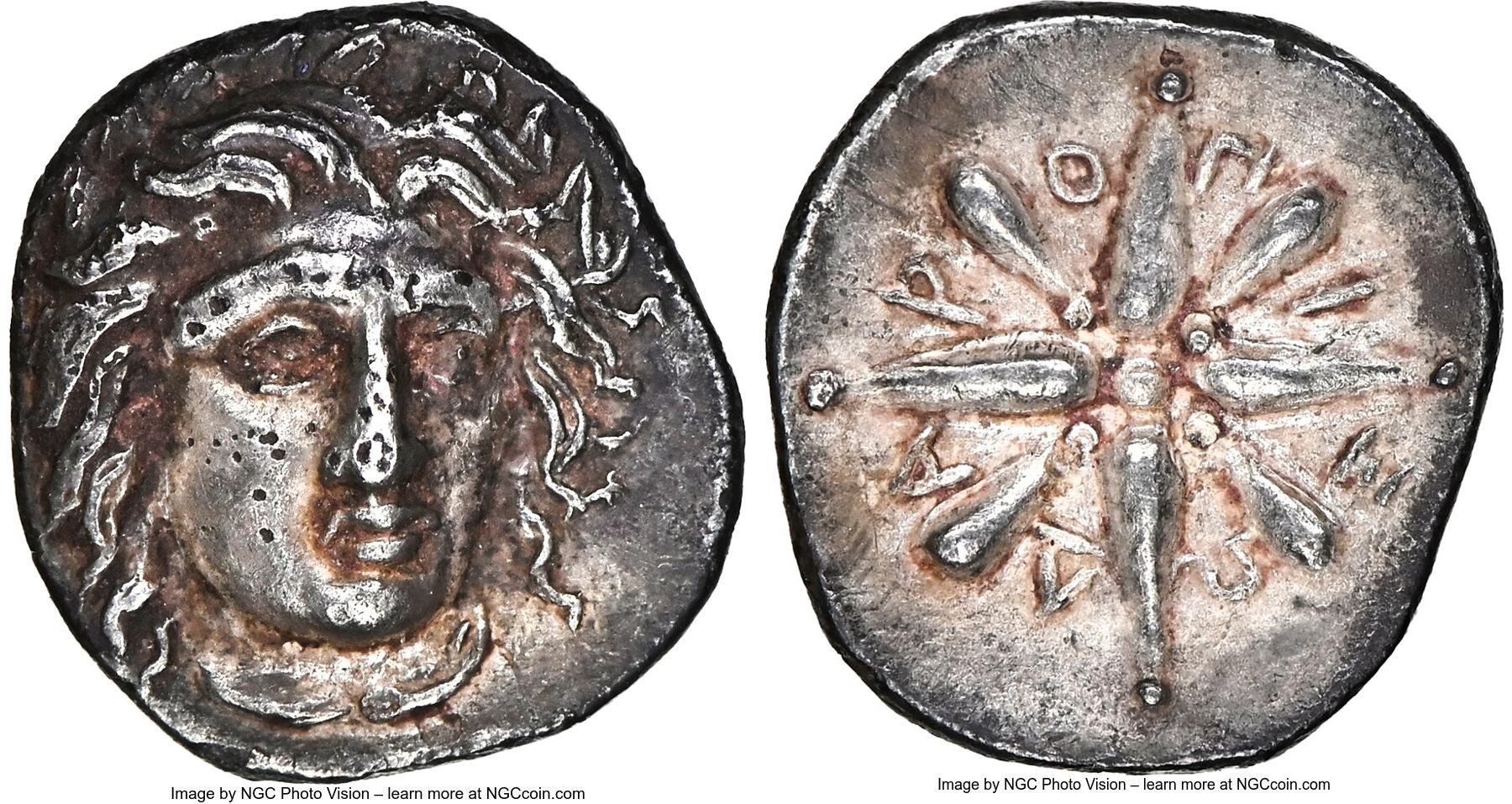Halicarnassus (Pixodarus), silver, trihemiobols (Apollo/eight rays pattern) (340-335 BCE)
From SILVER
340 BCE - 335 BCE Silver 32 kg
Description
| ObverseInscription or printing placed on the obverse.: | Laureate bust of Apollo facing, turned slightly right, hair parted in center and swept to either side, cloak fastened around neck. |
| ReverseInscription or printing placed on the reverse.: | ΠIΞΩΔAPO (Greek).Π-I-Ξ-Ω-Δ-A-P-O, letters between the eight rays of a Milesian styled star. |
Mint and issuing power
| MintIdentifies the place of manufacture or issue of a numismatic object.: | Halicarnassus | Ancient regionAncient region.: | Caria | Modern countryModern country: Turkey | AuthorityIdentifies the issuing power. The authority can be "pretended" when the name or the portrait of X is on the coin but he/she was not the issuing power. It can also be "uncertain" when there is no mention of X on the coin but he/she was the issuing power according to the historical sources: | Persian Empire, Pixodarus of Caria (satrap of Caria, 340-335 BC), Hecatomnid dynasty |
Chronology
| FromIdentifies the initial date in a range assigned in a numismatic context. | 340 BCE | toIdentifies the final date in a range assigned in a numismatic context.. | 335 BCE | PeriodTime period of the numismatic object.: Classical 480-323 BC |
Physical description
| MetalThe physical material (usually metal) from which an object is made.: | Silver |
Median weightMedian of the weights of numismatic objects (in grams). in grams | 0.80 | DenominationTerm indicating the value of a numismatic object. Examples: tetradrachm, chalkous, denarius.: | trihemiobol |
StandardStandard.: |
Image

AC256a Halicarnassus.jpeg [1]
References
| Die study referencePublication of the study: | Konuk 1998b1Konuk 1998b, n° 273-276. | ||
| Coin series referenceReference to coin series study: | RQEMAC2RQEMAC, n° 256a | ||
| Coin series web referenceCoin series web references: | |||
Obverse dies distribution
no distribution is available
Reverse dies distribution
no distribution is available
Quantification
| Number of obversesNumber of obverse dies. ᵖ (o) | 2 | Number of singletons (o1)The number of singleton coins. ᵖ | |
| Number of reverse diesNumber of reverse dies. (r) | 4 | Number of coinsNumber of coins. (n) | 20 |
| Coins per obverse dieNumber of coins per obverse die. (n/o) | 10 | Coins per reverse dieNumber of coins per reverse die. (n/r) | 5 |
| Reverse per obverse ratioRatio of obverse dies divided by reverse dies. (r/o) | 2 | Percentage of singletons (o1)number of coins (n) divided by the number of singletons (o1) ᵖ | % |
| Original number of dies (O) (Carter 1983 formula)The estimation of the number of coins according to Carter 1983 ᵖ | 2.03 | Coins struck if 20,000 as average productivity per dieCoins made if the average productivity for obverses (according to Carter) is 20,000. ᵖ | 40,600 |
| Original number of dies (O) (Esty 2011 formula)The estimation of the number of coins according to the singleton formula in Esty 2011 ᵖ (O) | 2.22 | Survival rate if 20,000 as average productivity per dieSurvival rate if average productivity is 20,000. ᵖ | 0.00049 |
| Coverage (o = % of O) (Esty 1984 formula)Esty 1984 - coverage (% of O) ᵖ (o = % of O) | % | Die productivity if survival rate 1/2,000Average productivity if survival rate is 1/2,000. ᵖ | 19,704.43 |
| Weight of silver (in kg) if 20,000 coins per die (O = Carter formula)Carter 1983 * Median weight * 20000 (*10 if gold or electrum) ᵖ | 32 kg <br /> 32 kg | Die productivity if survival rate 1/5,000Average productivity if survival rate is 1/5,000. ᵖ | 49,261.08 |
Remarks
Most likely one single workstation